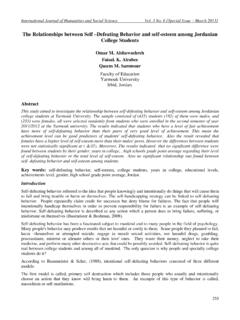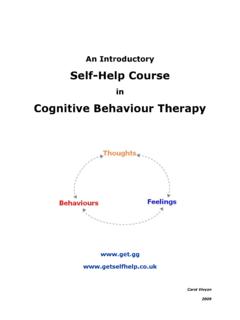Transcription of Overcoming Disordered Eating - Possibilities …
1 Page 1 Psychotherapy Research Training C C I entre for linical nterventions Module 6: Improving low self - esteem Overcoming Disordered Eating Overcoming Disordered Eating Information Pack B In Charge .. Mindset Matters Module 6 Improving low self - esteem Introduction 2 Adjusting the Rules 2 Worksheet: Adjusting the rules (example) 3 Worksheet: Adjusting the rules 4 Adjusting Your Negative Core Beliefs 5 Worksheet: Adjusting negative core beliefs (example) 7 Worksheet: Adjusting negative core beliefs 8 An Ongoing Process 9 Module Summary 10 About This Module 11 This is the sixth module of Information Pack B, which provides information and strategies to help you start changing the thoughts associated with your Disordered Eating and weight control habits. We recommend that you do not proceed with this Information Pack unless you have worked through Information Pack A, which offers strategies to change your Disordered behaviours.
2 We also recommend that you work through all the modules in this Information Pack in order. If you do think you might suffer from an Eating disorder, it is important that you talk to your General Practitioner, as there are many physical complications that can arise from being at an unhealthily low weight or from losing weight very quickly, or from purging. We advise you to seek professional help with working on an Eating disorder. If you use any extreme weight control behaviours even rarely you should also see your General Practitioner for a full medical check-up, as your health might be compromised. Such extreme measures include: extreme food restriction/fasting (and/or rapid weight loss) purging ( self -induced vomiting, misuse of laxatives or diuretics) extreme exercise The information provided in this document is for information purposes only. Please refer to the full disclaimer and copyright statement available at regarding the information on this website before making use of such information.
3 Page 2 Psychotherapy Research Training C C I entre for linical nterventions Module 6: Improving low self - esteem Overcoming Disordered Eating Introduction In the last module we talked about what low self - esteem is, how it develops, and how it is related to Eating disorders. We also asked you to identify any unhelpful rules and assumptions you might have. This module follows on from Module 5, and will show you how to address the problem of low self - esteem . Adjusting the Rules Rules and assumptions can be changed. You can work at challenging your rules and assumptions for living in a step-by-step way, using a worksheet. On page 4, you will find a worksheet for you to complete. Before doing that, read through the following guidelines and refer to the example on page 3. 1. Identify an unhelpful rule and/or assumption for living that you would like to challenge. 2. Think about how this rule and/or assumption has impacted your life.
4 Ask yourself: How has this rule affected my relationships, work or studies, how I take care of myself or engage in social or leisure activities? Evaluating the effect of unhelpful rules and assumptions is important because you not only want to change and adjust these rules, you also want to change how they affect your life. 3. Ask yourself how you know when this rule is active in your life. How do you feel? What are the things you do and say (to yourself or others)? 4. Ask yourself, Where did the rule come from? You need to understand how the rule developed and what might have kept it going. Unhelpful rules and assumptions may have made sense in the past, and you may have adopted them to cope from day-to-day. However, the rule may not still be relevant now. Ask yourself, Is this rule still necessary? Is it useful? 5. Next, ask yourself, In what ways is this rule (and/or assumption) unreasonable? Unhelpful rules and assumptions are inflexible and rigid.
5 Sometimes when you use them, you don t recognise that the world around you does not behave that way in general. Also, they may have been made when you were a child. You don t have to live according to the rules you made in the past. 6. Although unhelpful rules and assumptions are not beneficial in the long term, there might be certain advantages in living according to these rules. It is probably why you still have these rules and assumptions. Make a list of these advantages. 7. What are the disadvantages of living according to this rule/assumption? Are the advantages you identified really genuine? Ask yourself how this rule/assumption might limit your opportunities, prevent you from experiencing fun and pleasure, negatively impact on your relationships, or prevent you from achieving your life goals. Write these down and compare them with the advantages you had identified. 8. Now, think carefully about what might be a more balanced rule what would be more realistic, flexible, and helpful?
6 Consider using less extreme terms such as sometimes, prefer, it would be nice Balanced rules and assumptions might end up being longer than old ones. This is because they are more sophisticated . If you find this difficult, don t worry. Give it a try and put it in practice for a week or so. You can always revise your rule as you become more familiar with the process. 9. The final step is to consider what you could do to put your new rule and assumption into practice. Remember that your old rule and assumption has been in operation for some time now. It is important that you have new behaviours so that the new rule can be house-broken and settle into your balanced belief system. Page 3 Psychotherapy Research Training C C I entre for linical nterventions Module 6: Improving low self - esteem Overcoming Disordered Eating Adjusting the Rules (example) Rule and/or Assumption I would like to Adjust I must do whatever it takes to stay slim, or else I will never have any friends What impact has this rule (and/or assumption) had on my life?
7 I put myself under a lot of pressure to stay slim. I use extreme measures to get rid of the food I eat & to burn the fat away I m always thinking & worrying about my weight & body. Sometimes I get so sick of it. How do I know this rule is in operation? Whenever I eat, I feel guilty I think, I shouldn t eat this. It will make me fat! If I happen to have eaten a big meal, I will use laxatives to get rid of the food. Where did this rule (and/or assumption) come from? My mother always said I was a fat kid & had to lose weight. Kids at school used to call me fat-face and whale. My mother made me go on all sorts of diets. In what ways is this rule (and/or assumption) unreasonable? When I say to myself, I must do whatever it takes .. I am being inflexible & unreasonable. It drives me to use extreme measures that might not be healthy. I don t think a lot of people go to such extreme measures to lose weight or stay slim. Nowadays people talk more about Eating a balanced diet & staying healthy.
8 I look around & I see a lot of overweight people who have friends. Advantages of this Rule It makes me conscious of my weight and my appearance. A lot of people say that I look very good and have a nice body. Disadvantages of this Rule It puts a lot of pressure on me. I am always conscious of my weight and my food intake. I can t be like some of my friends who don t seem to care what they eat. Sometimes it seems like I m so superficial that I only care about my weight and appearance. What is an alternative rule (and/or assumption) that is more balanced and flexible? I enjoy being slim & wearing nice clothes, however, it is more helpful if I think about trying to maintain a healthy lifestyle. Also, it is unlikely that my friends would only like me if I am very slim So, I can be I can be healthy & slim & have friends What can I do to put this rule (and/or assumption) into practice on a daily basis? Check out what healthy portions are & eat that amount without using laxatives after.
9 Exercise regularly rather than extremely vigorously. Ask my closest friends what it is that they like about me. Page 4 Psychotherapy Research Training C C I entre for linical nterventions Module 6: Improving low self - esteem Overcoming Disordered Eating Adjusting the Rules Rule and/or assumption I would like to adjust What impact has this rule (and/or assumption) had on my life? How do I know this rule is in operation? Where did this rule (and/or assumption) come from? In what ways is this rule (and/or assumption) unreasonable? Advantages of this Rule Disadvantages of this Rule What is an alternative rule (and/or assumption) that is more balanced and flexible? What can I do to put this rule (and/or assumption) into practice on a daily basis? Page 5 Psychotherapy Research Training C C I entre for linical nterventions Module 6: Improving low self - esteem Overcoming Disordered Eating Adjusting Your Negative Core Beliefs In Module 5 you identified some of your core beliefs, and you can now use the steps below to adjust them.
10 Remember to work on only one core belief at a time and take your time to work through the steps. Once you have worked through the process of adjusting one negative core belief, you will then be able to apply the method to others you want to change. Remember that core beliefs can be strong and it may take you a few attempts to adjust them. Don t give up, just take your time. You may want to do this exercise several times, each time with a new core belief. Here are some guidelines for completing the worksheet. There s an example of a completed worksheet on page 7, and a blank form for you to fill out on Page 8. 1. Choose one Negative Core Belief. Choose only ONE to begin working on, even if you ve identified more. Write that negative core belief in the top box of the worksheet on page 8. Note how much you believe the negative core belief now, as well as when it s most and least convincing. Note how the negative core belief makes you feel. 2. Develop a Balanced Core Belief.













